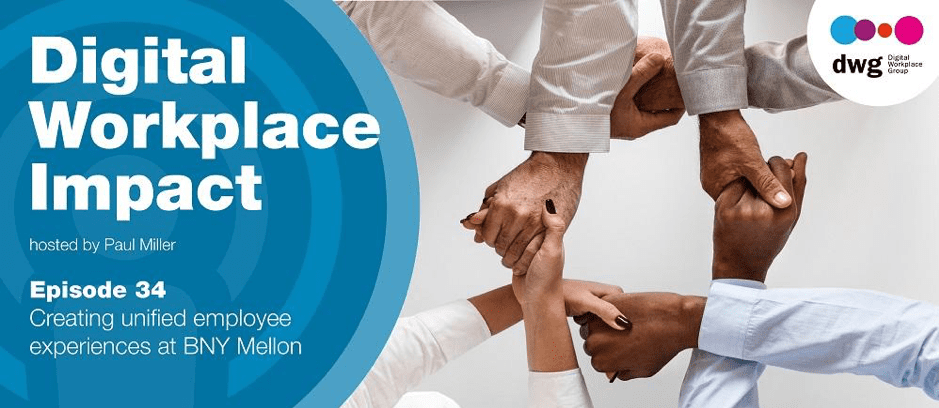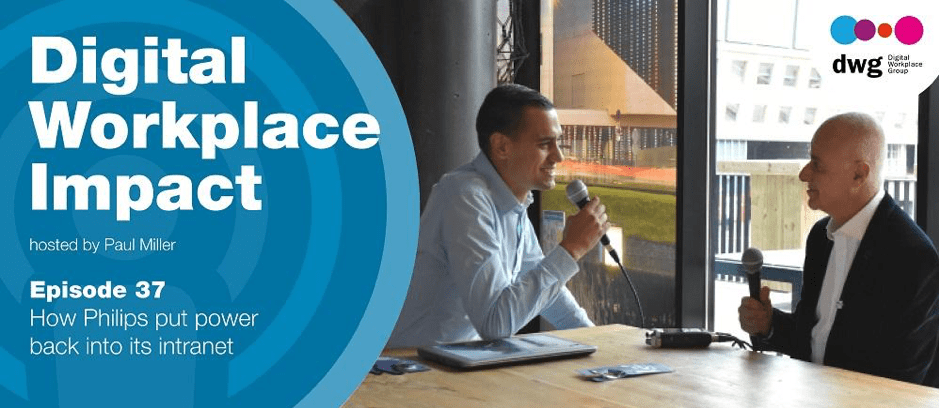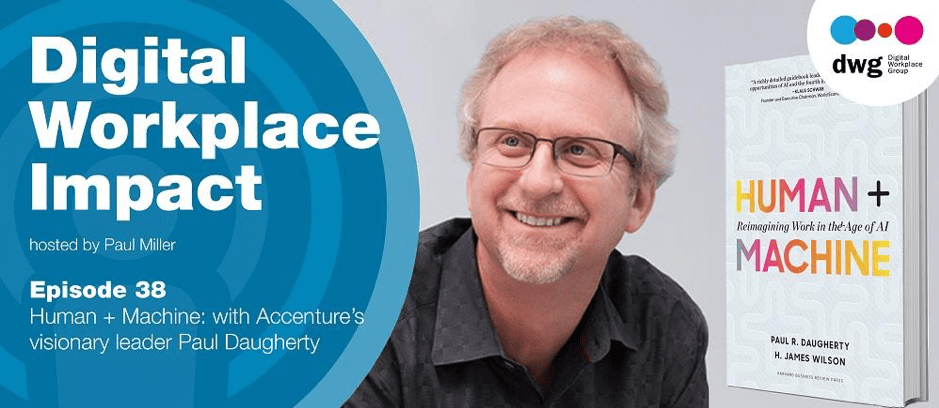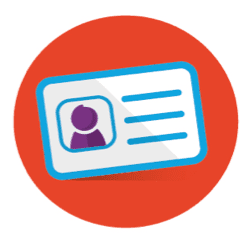Four more learnings about digital workplaces from the Digital Workplace Impact podcast
May 28, 2019 Updated: July 14, 2021
It’s hard to believe that we’re nearly up to 40 episodes of the Digital Workplace Impact podcast. Since the very first episode DWG’s CEO and Founder, Paul Miller, has spoken to a huge variety of people involved in the digital workplace and the future of work. From practitioners to thought leaders to disruptors through to visionaries in their field, we’ve learnt a lot and thoroughly enjoyed exploring the impact of the digital workplace. Here are four more learnings and takeaways that struck us from recent episodes. 
Episode 34: Creating unified employee experiences at BNY Mellon
Takeaway: Some innovative companies are bringing a new digital workplace paradigm to the intranet. In Episode 34 Paul spoke to Mike Fraietta, the product owner of BNY Mellon’s intranet, “My Source”. BNY Mellon is an innovator in the digital workplace space and has previously won our “Digital Workplace of the Year” award. So it is no surprise to learn that the bank is expanding the scope of the traditional intranet to become what Mike calls an “operating system” for the business. My Source tackles head-on one of the key issues for employees in the digital workplace – the proliferation of systems and applications that sometimes makes getting things done so difficult. How often do you have to have seven tabs or windows open at work? Like many intranets, My Source aims to be an entry point for the wider digital workplace but it brings data and content from separate applications into the intranet in a more comprehensive and consistent way. Leveraging an internal BNY Mellon platform called NEXEN, which aggregates content and data and has been used to develop the bank’s customer-facing offerings, the intranet allows users to access widgets from numerous different platforms and also use an integrated search capability. Functionality includes a place to aggregate notifications from all the different systems, as well as a “What’s Trending” feature which surfaces content and conversations from different applications. Essentially any system with an API can be plugged into NEXEN and the intranet. The podcast features some very interesting details about how BNY Mellon has implemented My Source, including how the back-end was implemented before the new interfaces so users didn’t even know there had been a change, as well as some of the change management aspects which have proved particularly challenging. While I’m not sure I’d call it an “operating system” it represents a completely new way of thinking of the intranet as an experience layer where you can plug in almost any application to help deliver a much better employee experience.
Episode 36: Fluid, agile, radical – that’s Dutch bank ING
Key takeaway: Strong communication and working well together is at the heart of implementing the digital workplace. In Episode 36 Paul spoke to Joris Kok, Product Owner of “One Intranet”, ING’s truly global and highly successful intranet which was developed by consolidating 500 separate intranets! ING is a global financial services company with 55,000 employees (70,000 if you include contractors) spread across 40 counties. Joris spoke about the highly ambitious and demanding project that led to the formation of the intranet, as well as the involvement of his team in continuing to manage and evolve the platform. A key ingredient of ING’s success in the digital workplace has been the ability of employees from different disciplines to communicate successfully and work closely together. Joris’s team of around 20 people is quite unusual in that it is itself cross-functional, consisting of business operations, developers and communicators. Spread across two locations in Amsterdam and Pune, India, the close integration of the team has been essential in helping to coordinate activities in the digital workplace, always delivered using an agile methodology. Managing all changes from an operations, development and business perspective helps to drive a successful platform, Joris argues. The team also facilitates strong communication throughout ING, acting as the bridge between the business and IT. Joris explained that often IT can misunderstand what the business wants on the platform; the role of his team is to make sure this does not happen. In fact, Joris goes on to say that the open dialogue between his team and different stakeholders throughout the business is one of the things he is most proud of. The podcast provides some very interesting insights into the processes which facilitate close communication and cooperation, including agile sprints, regular testing and demos. One also gets the impression that ING’s success is about the mindset of the people involved and their willingness to work towards a common goal.
Episode 37: How Philips put power back into its intranet
Key takeaway: Content governance, taxonomy and tagging are key foundations for an excellent intranet. Philips’ award-winning intranet serves the needs of a highly complex, global matrixed organization with over 70,000 employees across 100 countries. Launched in 2015, the new global intranet replaced a myriad of local intranets with little or no governance. Employees had to navigate to multiple sites to stay informed, internal communicators found it next to impossible to get messages out to the entire population and some local sites represented “ghost towns” with unreliable, out-of-date content. Moreover, findability was very poor – making it difficult for users to access the content they needed. In episode 37 of Digital Workplace Impact Paul Miller spoke to Dennis Agusi, Director of Communication Channels, about how the team at Philips went about building its new Office 365 intranet. A clear takeaway from the session is the importance of content governance in making an intranet truly essential. For those of you involved in designing and managing intranets (and the content within it) this will come as no surprise. Strict content governance and related processes have helped to keep content on the intranet fresh and findable. As part of the migration effort, the number of pages was reduced from a colossal 123,000 to around 5,000. Every page is now tagged with controlled terms from a consistent global taxonomy and has an owner. In addition, having topic owners and tagging items with different terms helps to drive approval workflow by requiring every piece of content to be approved by a relevant comms person. This move has also led to much better findability, with people now able to find what they need 80% of the time. It’s also very interesting to hear from Dennis about the importance of change management in training content owners to tag content and some of the resistance that was met, and how hiring a change management specialist was key. Establishing taxonomies, content governance and changing the way people work is not always easy, but they’ve clearly had great results at Philips and the hard work has all been worthwhile.
Episode 38: Human + Machine – with Accenture’s visionary leader Paul Daugherty
Key takeaway: AI presents challenges but also massive opportunities for the digital workplace, but we need to start reskilling people now. In Episode 38 Paul Miller had a fascinating conversation about AI and its impact with Paul Daugherty, Chief Technology and Innovation Officer at Accenture and co-author of the best-seller, “Human + Machine: Reimagining Work in the Age of AI”. The conversation between the two Pauls covers a number of themes and topics, and is well worth listening to – by the end you will almost certainly want to read the book! The premise of Daugherty’s work is that while AI and related automation causes massive disruption to roles, there has been a prevailing (and almost dystopian) view that the impact of AI will be all negative and that jobs will be lost forever. Daugherty believes that AI also creates many new roles and opportunities. When his earlier co-written article entitled “The jobs that AI will create” became MIT Sloan’s most downloaded article of the year, he set up a primary research project to look at how over 1,500 organizations are using AI and its relative impact. The findings, detailed in Paul’s book, reveal that AI is actually augmenting people’s roles at all skill levels, leading to people being able to carry out their jobs more effectively and having significant career opportunities. For example, even a tech leader like Tesla has had to reintroduce a lot of human roles to make automation work better. Meanwhile opportunities to create more individual, customized products, services and experiences are also leading to new roles. Another key takeaway from the podcast is that CEOs, as a critical imperative, need to be reskilling and retraining the people whose jobs are displaced by AI to take advantage of the new opportunities. This really stood out for me and ties in with some of the efforts organizations are making to drive digital literacy. AI will indeed have a profound impact on the digital workplace – and also the teams that run them.Subscribe to the Digital Workplace Impact podcast
There are many other fascinating episodes of Digital Workplace Impact to explore, browse all of them here. If you don’t want to miss an episode, why not subscribe? You can do so via iTunes, Stitcher Radio and SoundCloud. Happy listening!RESEARCH AND RESOURCES
- BLOG: Four digital workplace insights from the Digital Workplace Impact podcast
- FREE REPORT EXCERPT: Digital workplace adoption strategies: Proven approaches to bring users on board
- FREE REPORT: Digital workplace integration: Key approaches to drive benefits
TAKE THE NEXT STEP
Categorised in: Collaboration, Digital workplace, Internal communications, Intranets, Mobile sites & apps, Strategy & governance


